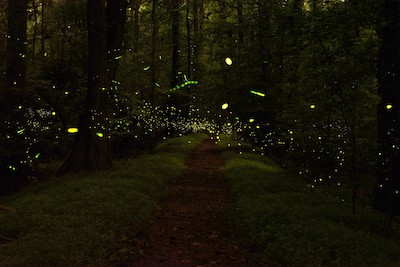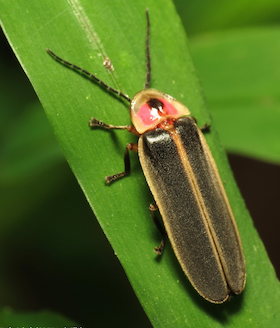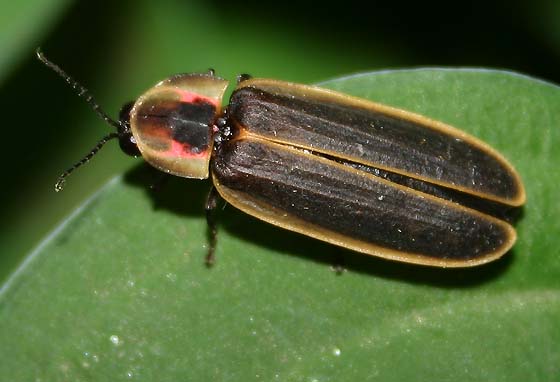Where Have All the Fireflies Gone?
by Kathleen Curthoys, Fairfax Master Gardener
 On June evenings, as twilight deepened to darkness in the wood line behind my house, the fireflies would rise to dance, seemingly thousands in a nighttime revelry, whirling, winking, blinking into the summer night.
On June evenings, as twilight deepened to darkness in the wood line behind my house, the fireflies would rise to dance, seemingly thousands in a nighttime revelry, whirling, winking, blinking into the summer night.
But that marvelous scene was years ago. The summer dance has dwindled. The sparkling theater of the wood line no longer appears to have even hundreds of the beetle revelers. Half a continent away, in a midwestern stand of woods with a path my family had dubbed Firefly Lane, the namesake stars of the show seem to have mostly left the stage.
Where have they gone?
Reports of fireflies diminishing and dwindling have become common in recent years. Anecdotal stories have led to scientific surveys that indicate their numbers are declining. The studies show that it’s not our imagination; our favorite childhood “bugs” are beset with threats, and some species are endangered.
A scientific study published in 2022 assessed some firefly populations around the world and found they face several factors working against them. In regions globally, loss of habitat, artificial light at night and use of pesticides were found to be three of the most serious threats to fireflies. Water pollution, soil pollution, climate and tourism also play a role.
In the eastern U.S., the study found the primary threats are, in order: habitat loss, pesticide use, light pollution and water pollution.
Habitat loss and degradation can range from residential and commercial development to agricultural activity and work in home gardens. Female fireflies tend to lay eggs in moist areas and wetlands. Woodland debris and leaf litter can provide moisture and a suitable environment for the larvae, which may be underground for two years before they emerge as adults. Larvae and adults may be present at ground level, where garden activity such as mowing and tilling can be disruptive to them.
Artificial light at night was cited as the second most serious threat globally, after habitat loss. As male fireflies flash their bioluminescent courtship signals, artificial light may interfere with the females receiving the message and replying with their own signals. This in turn can interfere with reproductive behavior and increase risk of extinction.

Photinus pyralis
An experiment in Virginia on the effect of artificial light on fireflies found that light pollution reduced courtship behavior and mating success for the most common firefly species in our area, Photinus pyralis. The effect may vary from one species to another, studies show.
LED bulbs in particular may be a factor. “LED bulbs emit light at all wavelengths, like sunlight, and this type of light may be more disruptive to nocturnal wildlife than the older outdoor light bulbs, such as sodium streetlights, which emit light at fewer spectral wavelengths,” said University of Virginia environmental sciences professor Kyle Haynes in an article on artificial light and fireflies. “The new bulbs are more energy-efficient, but unfortunately may be disruptive to organisms.”
Insecticides used against other dwellers in the lawn and garden may also affect fireflies. Eggs and larvae may be exposed to concentrations of chemicals in water or soil and on lawns. Adults may encounter them while on foliage or soil. Using insecticides such as pyrethroids to control mosquitoes may affect fireflies, especially if used at dusk when fireflies may be active.

Pyractomena dispersa
In a 2022 study focused on the status of fireflies in the U.S. and Canada, of 132 species assessed, 14 percent (18) were found to be threatened with extinction, categorized as either critically endangered (1), endangered (10) or vulnerable (7). Given that data was not available for another 70 species to determine their status, the scientists estimate the potential for nearly a third of species to be under threat of extinction.
Species listed as a conservation concern in Virginia are: Photuris patomaca, Pyractomena dispersa, Pyractomena lucifer and Pyractomena marginalis.
In our area, Photinus pyralis is the most common species. While it was not listed as endangered, it may still be affected by risk factors of habitat loss, light at night and pollution.
Why should we be concerned about fireflies?
These beetles of the family Lampyridae are predators. When they’re out at night, they’re not just looking for love. They want a meal, too. They scan the garden menu for slugs, snails, cutworms and other soil dwellers. When it comes to pest control, they can be the gardener’s friend.
How you can invite them back?
Fireflies prefer wooded areas to lawns. Consider leaving wood and leaf debris in lower-traffic areas such as wood lines. Grass allowed to grow tall can help keep moisture in the soil. This will promote a habitat for female fireflies to lay their eggs.
Check out your lighting at night and see if you can reduce it to avoid interfering with fireflies’ ability to communicate with each other and mate. Some measures to consider: installing shields on porch lights, closing curtains at night, putting lights on timers and limiting landscape lights and LED floodlights.
Instead of using broad-spectrum insecticides that kill a wide range of creatures, use organic means for controlling insects or choose less-toxic insecticides. Limit use of insecticides to specific problems and target areas where they are needed.
Communities may consider limiting bright lights at night in their areas.
Giving fireflies their kind of theater stage will let their summers of dancing in the dark go on and on.
Resources
• Xerces Society for Invertebrate Conservation
• Firefly Watch Community Science Project
• International Dark-Sky Association
• Global Perspective on Firefly Extinction Threats, Sara M. Lewis, Tufts University, et al., via BioScience
• Researchers study effects of artificial light on fireflies, Fariss Samarrai, University of Virginia, phys.org
• Night-lights: Light pollution impacts on fireflies and arthropod communities, Ariel Lee Firebaugh,
University of Virginia
• Firefly Species at Risk, Xerces Society for Invertebrate Conservation
• Keep The Fireflies Burning, Ray Novitske, Fairfax Gardening
• Evaluating firefly extinction risk: Initial red list assessments for North America, Candace E. Fallon,
et.al. National Library of Medicine